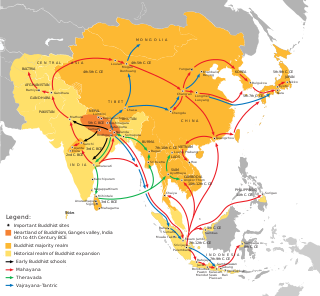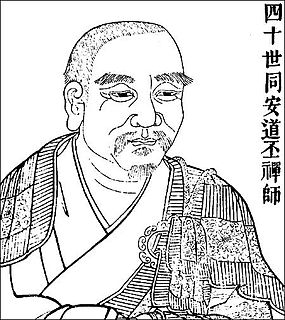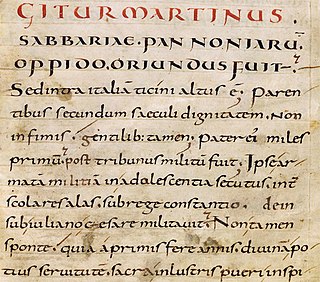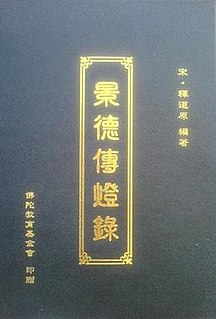
Siddhārtha Gautama or Siddhattha Gotama in Pali, also called the Gautama Buddha, the Shakyamuni Buddha or simply the Buddha, after the title of Buddha, was a monk (śramaṇa), mendicant, sage, philosopher, teacher and religious leader on whose teachings Buddhism was founded. He is believed to have lived and taught mostly in the northeastern part of ancient India sometime between the 6th and 4th centuries BCE.

Bodhidharma was a Buddhist monk who lived during the 5th or 6th century. He is traditionally credited as the transmitter of Chan Buddhism to China, and regarded as its first Chinese patriarch. According to Chinese legend, he also began the physical training of the monks of Shaolin Monastery that led to the creation of Shaolin kungfu. In Japan, he is known as Daruma.
Brahmin is a varna (class) in Hinduism specialising as priests, teachers (acharya) and protectors of sacred learning across generations.

Chanakya was an ancient Indian teacher, philosopher, economist, jurist and royal advisor. He is traditionally identified as Kauṭilya or Vishnugupta, who authored the ancient Indian political treatise, the Arthashastra, a text dated to roughly between the 2nd century BCE and the 3rd century CE. As such, he is considered the pioneer of the field of political science and economics in India, and his work is thought of as an important precursor to classical economics. His works were lost near the end of the Gupta Empire and not rediscovered until the early twentieth century.

A lineage in Buddhism is a line of transmission of the Buddhist teaching that is "theoretically traced back to the Buddha himself." The acknowledgement of the transmission can be oral, or certified in documents. Several branches of Buddhism, including Chan and Tibetan Buddhism maintain records of their historical teachers. These records serve as a validation for the living exponents of the tradition.

Pushyamitra Shunga was the founder and first ruler of the Shunga Empire in East India. He was a follower of Brahmanism.

Maha Kasyapa or Mahākāśyapa or Kāśyapa was one of the principal disciples of Gautama Buddha. He came from the kingdom of Magadha. He became an arhat and was the disciple of the Buddha who was foremost in ascetic practice.

The Pala Empire was an imperial power during the Late Classical period on the Indian subcontinent, which originated in the region of Bengal. It is named after its ruling dynasty, whose rulers bore names ending with the suffix of Pala. They were followers of the Mahayana and Tantric schools of Buddhism. The empire was founded with the election of Gopala as the emperor of Gauda in 750 CE. The Pala stronghold was located in Bengal and Bihar, which included the major cities of Vikrampura, Pataliputra, Gauda, Monghyr, Somapura, Ramvati (Varendra), Tamralipta and Jaggadala.

The decline of Buddhism in the Indian subcontinent refers to a gradual process of dwindling and replacement of Buddhism in India, which ended around the 12th century. According to Lars Fogelin, this was "not a singular event, with a singular cause; it was a centuries-long process."

Buddhism entered Han China via the Silk Road, beginning in the 1st or 2nd century CE. The first documented translation efforts by Buddhist monks in China were in the 2nd century CE via the Kushan Empire into the Chinese territory of the Tarim Basin under Kanishka. These contacts transmitted strands of Sarvastivadan and Tamrashatiya Buddhism throughout the Eastern world.

Jianzhi Sengcan is known as the Third Chinese Patriarch of Chán after Bodhidharma and thirtieth Patriarch after Siddhārtha Gautama Buddha.

The Vakataka Empire was a dynasty from the Indian subcontinent that originated from the Deccan in the mid-3rd century CE. Their state is believed to have extended from the southern edges of Malwa and Gujarat in the north to the Tungabhadra River in the south as well as from the Arabian Sea in the west to the edges of Chhattisgarh in the east. They were the most important successors of the Satavahanas in the Deccan and contemporaneous with the Guptas in northern India.

Kātyāyana or Mahākātyāyana was a disciple of Gautama Buddha.

The Kalabhra dynasty, also called Kalabra, Kalappirar or Kalvar were rulers of all or parts of Tamil region sometime between 3rd-century and 6th-century CE, after ancient dynasties of early Cholas, early Pandyas and Chera. Information about the origin and reign of the Kalabhras is uncertain and scarce. Their proposed roots vary from southeast region of modern Karnataka, Kalappalars of Vellala community, to Kalavar chieftains. The Kalabhra era is sometimes referred to as the "dark period" of Tamil history, and information about it is generally inferred from any mentions in the literature and inscriptions that are dated many centuries after their era ended.

Āryadeva, was a disciple of Nagarjuna and author of several important Mahayana Madhyamaka Buddhist texts. He is also known as Kanadeva, recognized as the 15th patriarch in Chan Buddhism, and as "Bodhisattva Deva" in Sri Lanka.

Kaundinya, Kauṇḍinya, or Koṇḍañña (Pali), also known as Ājñātakauṇḍinya, Pali: Añña Koṇḍañña, was a Buddhist monk follower of Gautama Buddha and the first to become an arhat. He lived during the 6th century BCE in what are now Uttar Pradesh and Bihar, India. According to traditional accounts, at the time of Gautama Buddha's birth, he predicted his future destination as an enlightened teacher.

Chan, from Sanskrit dhyāna, is a Chinese school of Mahāyāna Buddhism. It developed in China from the 6th century CE onwards, becoming dominant during the Tang and Song dynasties. After the Yuan, Chan more or less fused with Pure Land Buddhism.

Yunju Daoying was a Zen Buddhist monk and teacher during the late Tang Dynasty. According to traditional biographies, he became a monk when he was 25 at Yanshou Temple, although he later left to study at Mount Nan before finally taking on Dongshan Liangjie as his teacher on Mount Dong. After receiving dharma transmission from Dongshan, he went to a place called Three Peak Hermitage, and finally to Mount Yunju, northeast of modern Nanchang in Jiangxi Province. Here he established Jenru Temple, where he taught for 30 years and eventually attracted 1,500 students.

Tongan Daopi was a Zen Buddhist monk during the end of the Tang Dynasty and the beginning of the Five Dynasties and Ten Kingdoms period. Very little is known about him. Traditional biographies record that he was the abbot of Tongan Monastery on Mount Fengchi near modern Nanchang. The earliest source of information on monks of this era is the Zutang ji, which was completed in 952, but it fails to mention Tongan Daopi as a disciple of his supposed teacher Yunju Daoying. The Zutang ji does, however, record someone with the name Tongan asking a question to Yunju Daoying. The scholar Ui Hakuju has written this could likely refer to Tongan Daopi. He is first explicitly mentioned in the Transmission of the Lamp, which was compiled around 1004. However, in that work, it does not mention Tongan Daopi as having any disciples. The commonly accepted version of his lineage holds that Tongan Guanzhi is Tongan Daopi's successor. However, this comes from Huihong's Sengbao zhuan, which was completed in 1119, much longer after Tongan's death than the other works. The Transmission of the Lamp instead claims that Tongan Guanzhi is the disciple of a Tongan Wei, in turn a student of Jufeng Puman, with Jufeng being an apparently obscure student of the famous Dongshan Liangjie. Both Tongan Wei and Jufeng Puman are listed for the first time in the Transmission of the Lamp, and neither with much information. However, Dayang Jingxuan, who in Huihong's version of the lineage is a descendant of Tonagan Daopi, is recorded in the Transmission of the Lamp as being descended through Jufeng Puman and Tongan Wei. Dayang was close with Wang Shu, one of the compilers of Transmission of the Lamp, suggesting that it is unlikely that an error would have been made therein about his lineage. This suggests that Tongan Guanzhi is much more likely to have been a student of Tongan Wei and not Tongan Daopi as commonly accepted.


















